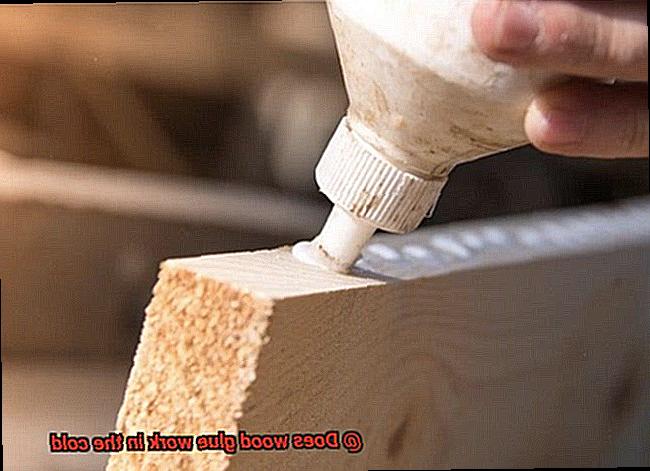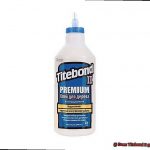Welcome to our woodworking blog, where we’re about to tackle a question that has stumped many craftsmen: does wood glue work in the cold? Picture this: it’s a freezing winter day in your workshop, the smell of fresh pine filling the air. You’ve got a project in mind, but the temperature has dropped big time. Will your trusty wood glue hold up when faced with icy conditions?
Wood glue has been a staple for years, but its performance can change depending on the temperature. The regular stuff is meant to work best between 55°F and 80°F (13°C and 27°C). But when things get colder than that, problems may arise.
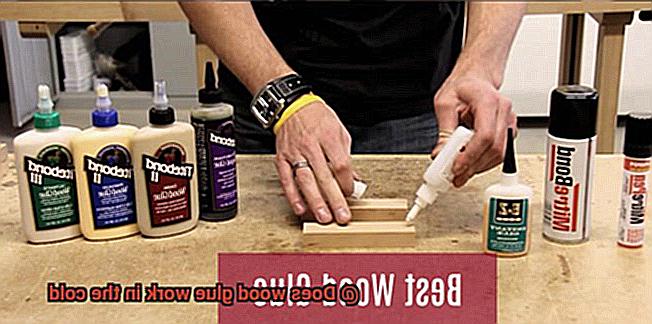
Cold temperatures can mess with how wood glue dries, how strong it bonds, and how well it works overall. In low temps, the moisture in the glue takes longer to evaporate, meaning it takes longer to dry. Plus, the cold can make the glue thicker and harder to spread evenly. This could spell trouble for your project – weakened joints or even total bond failure.
But don’t worry. Manufacturers have come up with special formulas just for chilly weather. These glues have additives that keep them from freezing or getting too thick when it’s cold out. They’re made to work their magic even when it feels like you’re working in an icebox.
Of course, always read the instructions on your glue bottle carefully. Some cold-weather glues will mention a minimum temperature they can handle. Sometimes even just above freezing could be challenging, so listen to what the manufacturer says.
In the next sections, we’ll dive into all things wood glue and cold weather. We’ll explore what affects its performance, techniques for successful bonding in the cold, and some key tips to make your winter woodworking sessions a breeze. So stick around (pun intended), because we’re about to uncover all you need to know about wood glue in freezing temps. Let’s get started on solving this winter woodworking mystery.
What are the Recommended Working Temperatures for Wood Glue?
Contents
- 1 What are the Recommended Working Temperatures for Wood Glue?
- 2 Challenges of Using Wood Glue in Cold Weather
- 3 Methods to Improve Performance of Wood Glue in Cold Temperatures
- 4 Room Temperature Storage for Optimal Consistency
- 5 Warming up Surfaces Before Applying the Glue
- 6 Cold Weather Formulas of Wood Glue
- 7 Conclusion
In the world of woodworking, wood glue is the unsung hero that holds everything together. But did you know that temperature plays a vital role in its performance? In this article, we will delve into the recommended working temperatures for wood glue, equipping you with the knowledge to achieve flawless bonding, regardless of the weather conditions.
The Ideal Temperature Range:
For optimal results, most wood glues thrive between 50°F (10°C) and 90°F (32°C). Within this sweet spot, you strike the perfect balance between curing time and bond strength. Let’s explore how different temperatures can affect the performance of wood glue.
Effects of Cold Temperatures:

When the mercury plummets below 50°F (10°C), wood glue takes its sweet time to cure. The cold chills the chemical reaction responsible for bonding, resulting in feeble connections. In extreme cold, the glue might not cure at all, leaving you with a disjointed mess. Fear not. To overcome this challenge, consider pre-warming both the surfaces and the glue itself before application.
Effects of High Temperatures:
On the other end of the spectrum, temperatures exceeding 90°F (32°C) can also wreak havoc on wood glue performance. The scorching heat causes the glue to dry hastily, impeding proper penetration into wood fibers and compromising bond strength. Additionally, working time is cut short, making it an uphill battle to position and clamp pieces before the glue sets.
Tips for Cold Weather Bonding:
If you find yourself braving chilly conditions, worry not. Here are some tips to supercharge your wood glue:
- Pre-warm surfaces: Warm up those icy wood surfaces using a heat gun or hairdryer before applying the glue. This ensures they are ready for a cozy bonding session.
- Warm up the glue: Transform your glue from frigid to fiery by placing the bottle in warm water for a few minutes. This elevates its temperature and enhances its flowability.
- Consider cold weather glues: Some manufacturers offer specialized wood glues formulated specifically for cold weather applications. These glues are your trusty companions during the colder seasons, defying low temperatures and performing splendidly.
Challenges of Using Wood Glue in Cold Weather
Wood glue is a woodworker’s best friend, but when the temperature drops, its effectiveness can be compromised. In this article, we will delve into the challenges of using wood glue in cold weather and explore strategies to overcome them. So grab a hot cup of coffee and let’s dive in.
Extended Drying Time:
The first challenge we encounter when using wood glue in cold weather is the extended drying time. Most wood glues require a specific temperature range for proper curing, typically between 50 to 80 degrees Fahrenheit. When the mercury drops below this range, the curing process slows down significantly, leaving us waiting longer for our project to dry.
Solution: Consider using a specialized cold weather wood glue that is formulated to cure at lower temperatures. These glues are designed to provide reliable bonding even in chilly conditions.
Viscosity Troubles:
As the temperature decreases, so does the viscosity or thickness of wood glue. This can make it harder to spread evenly on wood surfaces and achieve a strong bond. Uneven application can lead to weak spots in your project.
Solution: Before applying the glue, warm it up by placing the bottle in warm water or using a hairdryer on low heat. This will help restore the ideal viscosity and make it easier to spread.
Wood Shrinkage:
In cold weather, wood tends to contract and shrink, creating gaps between the pieces being joined together. These gaps can compromise the bond created by the glue and weaken the overall structure.
Solution:
- Ensure that your wood is properly acclimated to the temperature of your workspace before applying glue.
- Consider clamping your project until the glue has fully cured to counteract any potential shrinkage.
Moisture Interference:
Cold temperatures often come hand-in-hand with high humidity levels, which can interfere with the bonding process. Moisture prevents proper adhesion and weakens the strength of the bond.
Solution:
- Prior to applying wood glue, ensure that both the wood surfaces and the glue itself are dry.
- Wipe off any excess moisture or condensation from the wood.
- Store your glue in a dry environment to prevent moisture absorption.

Freezing Temperatures:
When the temperature drops below freezing, some types of wood glues can lose their adhesive properties altogether. The water-based components in these glues can freeze and separate from the adhesive, rendering it ineffective for bonding wood.
Solution: If you anticipate freezing temperatures, consider using a specialized cold weather wood glue that is designed to withstand extreme cold conditions. These glues are formulated to resist freezing and maintain their adhesive properties.
Methods to Improve Performance of Wood Glue in Cold Temperatures
Wood glue is a reliable companion for woodworking projects, but when the mercury drops, it can pose challenges. Fear not. There are several effective methods to boost the performance of wood glue in cold temperatures. So, grab a warm drink, sit back, and let’s explore these invaluable tips.
Pre-Warming: The Key to Success
Before applying wood glue, consider pre-warming both the wood and the glue. By storing them in a warm room or using a hairdryer to gently heat them up, you can decrease the viscosity of the glue. This makes it easier to work with and ensures a smoother application.
Cold Weather Formulas: Your Savior
Certain manufacturers produce wood glues specially formulated for chilly environments. These cold weather formulas have lower viscosities and often contain additives that prevent freezing or thickening in low temperatures. Opting for these specialized glues is a wise choice when working in colder climates.
Thinning with Water: A Game Changer
Adding a small amount of water to wood glue can significantly improve its performance in cold temperatures. Water acts as a thinning agent, reducing the viscosity of the glue for seamless application. Remember not to go overboard, as excessive water can compromise the strength of the bond.
Apply Pressure for Optimal Curing
Applying pressure during the curing process is crucial for achieving exceptional results with wood glue in cold temperatures. Using clamps or weights to hold glued pieces together tightly promotes effective curing even in chilly conditions. This technique helps squeeze out excess moisture from the glue and guarantees a robust bond.
Climate-Controlled Storage: A Must
To prevent wood glue from being exposed to extreme cold temperatures, store it in a climate-controlled environment. Maintaining the glue at room temperature or slightly above helps preserve its viscosity and overall performance. This simple step ensures that your wood glue is ready for action, regardless of the weather outside.
Room Temperature Storage for Optimal Consistency
Wood glue is a versatile adhesive that is essential for woodworking projects. Its ability to bond wood surfaces together makes it a go-to tool for carpenters and DIY enthusiasts. However, the consistency and effectiveness of wood glue can be compromised by temperature variations. To ensure optimal performance, it is crucial to store wood glue at room temperature.
Temperature plays a significant role in determining the consistency of wood glue. Cold temperatures can cause the glue to thicken or even freeze, making it difficult to use. Thickened glue becomes harder to spread evenly and may not bond as effectively. Freezing can irreversibly damage the glue, rendering it useless. To avoid these issues, store wood glue in an environment where the temperature is between 60°F and 75°F (15°C to 24°C).
If you live in an area with extremely cold winters, make sure to store your wood glue in a climate-controlled space. This could be inside your home or in a heated workshop. Avoid leaving the glue in garages, sheds, or other areas exposed to freezing temperatures. Storing the glue in a cool, dry place away from direct sunlight is also ideal.
In addition to temperature, humidity can affect the performance of wood glue. High humidity can prolong curing time and result in weaker bonds. Therefore, it is best to store wood glue in a place with moderate humidity levels.
Before using wood glue in cold temperatures, allow it to warm up to room temperature. Bring the glue indoors and let it acclimate for a few hours before use. Cold glue may not spread smoothly or bond effectively until it reaches its optimal temperature range.
Some wood glues are specifically formulated for cold weather applications, designed to withstand lower temperatures while maintaining effectiveness. If you anticipate working with wood glue in cold conditions, consider using a cold weather formula.
Always refer to the manufacturer’s instructions and recommendations for storing and using wood glue. Different brands and types of glue may have specific guidelines to ensure optimal performance, especially in cold temperatures.
Warming up Surfaces Before Applying the Glue

In the world of woodworking, achieving a solid bond is paramount to the success of any project. However, when working in cold temperatures, the performance of glue can be compromised. That’s why it’s essential to warm up surfaces before applying the adhesive. In this article, we’ll delve into the importance of this step, explore various warming methods, discuss potential benefits and drawbacks, and provide additional considerations for optimal glue application.

The Importance of Warming Up Surfaces:
Enhances Bond Strength: Cold temperatures cause wood to contract and become less porous, making it challenging for glue to penetrate effectively. By warming up the surfaces, wood becomes more receptive to the adhesive, allowing it to seep into the pores and create a stronger bond.
Methods to Warm Up Surfaces:
- Heat Gun or Hairdryer: Gently direct warm air onto the wood using a heat gun or hairdryer. Caution should be exercised to avoid excessive heat or holding it too close to prevent material damage.
- Warm Environment: Store the wood indoors or in a heated space for a few hours before gluing. Raising the temperature of the wood ensures that it is not too cold when applying the glue.
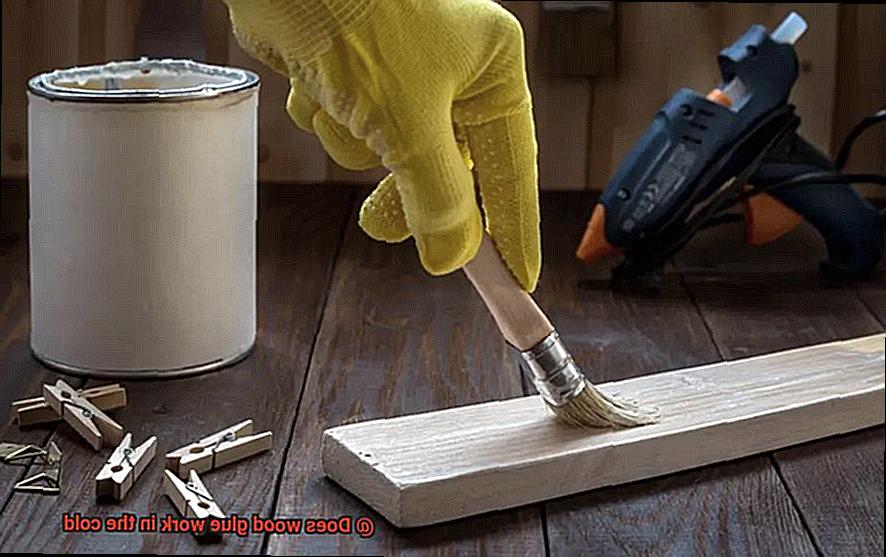
Potential Benefits and Drawbacks:
Benefits:
- Improved Bond Strength: Warming up surfaces optimizes glue penetration into wood fibers, resulting in a stronger bond.
- Enhanced Workability: Warmer wood is more pliable, making it easier to manipulate and position during assembly.
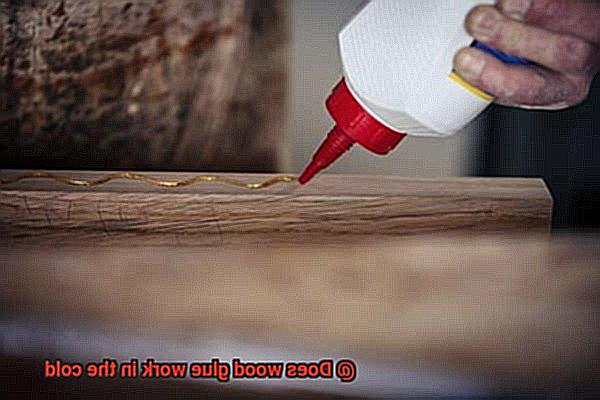

Drawbacks:
- Time-consuming: Warming up surfaces may require additional time and planning before starting your project.
- Adhesive Viscosity: Extremely cold temperatures can affect adhesive viscosity, making it challenging to spread evenly. Working in temperatures above 50°F (10°C) is recommended for optimal glue performance.
Additional Considerations:
- Specialized Cold Weather Wood Glue: In extremely cold conditions, using specialized cold weather wood glue can be beneficial. These glues are formulated to perform better in lower temperatures, providing a stronger bond even in chilly conditions.
Cold Weather Formulas of Wood Glue
Imagine yourself in a cozy workshop, surrounded by beautiful wooden pieces waiting to be joined together. But there’s a catch – it’s freezing outside, and you’re worried about your glue holding up in the cold. Fear not. We have the secret weapon that will keep your projects intact even in the chilliest of temperatures – cold weather wood glue.
The Science Behind Cold Weather Formulas:
Wood glues have varying tolerance levels for cold temperatures. For cold weather projects, it is crucial to choose a wood glue specifically designed to withstand low temperatures.
Cold weather formulas of wood glue feature higher solids content, ensuring a stronger bond even in freezing conditions.
Special additives are incorporated into these formulas to enhance flexibility and resistance to temperature changes. This prevents the glue from becoming brittle and ensures optimal performance in cold weather.
Spreadability and Penetration:
Cold weather formulas exhibit improved spreadability and lower viscosity, allowing for better penetration into wood fibers.
This exceptional penetration guarantees a strong bond, even when Jack Frost is nipping at your project.
Application Tips:
Follow the manufacturer’s instructions regarding application temperature and storage conditions.
Storing the glue at room temperature before use and ensuring that the materials to be bonded are at a similar temperature will significantly improve bond strength.
When Extreme Cold Strikes:
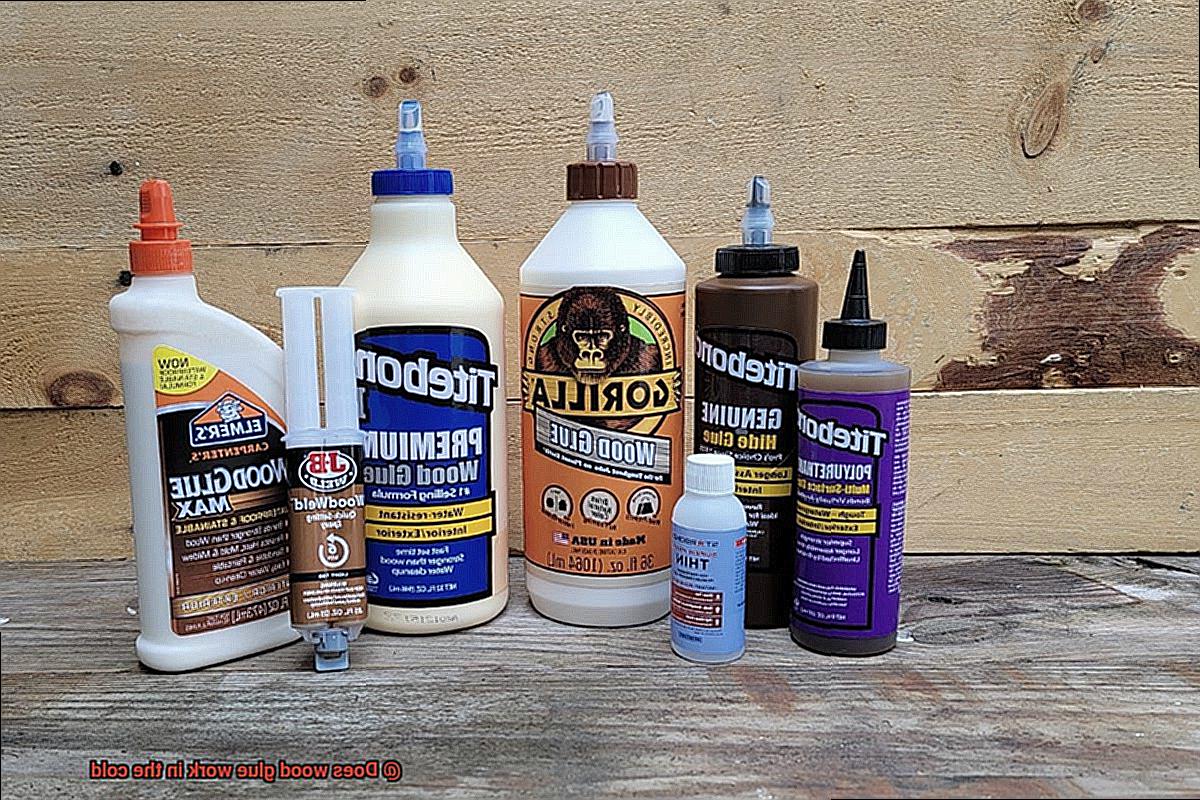
In some cases, extreme cold may call for alternative bonding methods like mechanical fasteners or different adhesive types.
Extremely low temperatures can challenge even the best cold weather wood glues, so it is important to assess the specific requirements of your project.
Also Read: Glue Types
Conclusion
In conclusion, the effectiveness of wood glue can be compromised in cold temperatures. When the mercury drops below the optimal range of 55°F to 80°F (13°C to 27°C), problems may arise. The frigid conditions cause the glue to dry slower, thicken up, and become a challenge to spread evenly. Ultimately, this weakens the overall bond.
Thankfully, manufacturers have come up with specialized formulas of wood glue specifically designed for freezing weather. These innovative glues contain additives that prevent freezing or thickening in low temperatures. With these cold-weather formulas at your disposal, you can rest assured that your woodworking projects will hold strong even in icy conditions. Just be sure to carefully read the instructions on your glue bottle and choose the appropriate formula for your needs.
To maximize the performance of wood glue in chilly temperatures, it’s recommended to pre-warm both the surfaces and the glue itself. This can easily be achieved by using a heat gun or hairdryer to warm up the surfaces before applying the adhesive. Additionally, there are other helpful tips to consider such as opting for cold weather glues, thinning with water if necessary, applying pressure during curing, and storing the glue in a climate-controlled environment.
With these precautions and techniques in mind, wood glue can still be relied upon even when Jack Frost is nipping at your fingertips. By following these guidelines, you’ll ensure successful bonding for all your winter woodworking endeavors.

